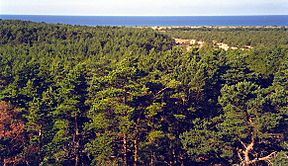Gotska Sandön facts for kids
Quick facts for kids Gotska Sandön National Park |
|
|---|---|
|
IUCN Category II (National Park)
|
|

The eastern coast, as seen from the lighthouse.
|
|
| Location | Gotland County, Sweden |
| Nearest city | Fårösund, Gotland Municipality |
| Area | 44.9 km2 (17.3 sq mi), of which 8.42 km2 (3.25 sq mi) are water. |
| Established | 1909, extended in 1963 and 1988 |
| Governing body | Naturvårdsverket |
Gotska Sandön is a special island in Sweden, found in the Baltic Sea. It's like a hidden gem, located about 38 kilometres (24 miles) north of another island called Fårö. This island is quite long, stretching about 9 kilometres (5.6 miles), and about 6 kilometres (3.7 miles) wide. Its total land area is around 36 square kilometres (14 square miles).
The name "Gotska Sandön" actually means "The Gotlandic Sand Island." This is a perfect name because the island is mostly made of sand! You'll find lots of beautiful sandy beaches, tall sand dunes, and thick pine forests here. In 1909, Gotska Sandön became one of Sweden's national parks. This means it's a protected area where nature is kept safe. During the summer, you can take boat trips to the island from Fårö and Nynäshamn.
Contents
What Makes Gotska Sandön Special?
Gotska Sandön is famous for its unique sandy landscape. It's a place where nature has been allowed to grow wild and free. The island's shape and features are always changing because of the wind and waves moving the sand around.
A Sandy Paradise
The island's main feature is its sand. You can find huge sand dunes that look like small mountains. These dunes are constantly shifting, creating new shapes and patterns. Walking on them feels like exploring a desert, but with the sea nearby.
Forests and Plants
Even though it's sandy, Gotska Sandön has large forests, mostly made up of pine trees. These trees are very tough and can grow well in the sandy soil. You can also find many different kinds of plants that are used to living in sandy, coastal areas. Some of these plants are quite rare.
Wildlife on the Island
Gotska Sandön is home to many animals, especially birds. It's a peaceful place for them to live and raise their young, far from busy human areas.
Birdwatching Haven
Many different types of birds visit or live on Gotska Sandön. It's a great spot for birdwatching, especially during spring and autumn when birds are migrating. You might see sea eagles, various seabirds, and many smaller forest birds.
Other Animals
Besides birds, you might also spot some seals resting on the beaches or swimming in the waters around the island. There are also insects and small animals that have adapted to life in this sandy environment.
History of the National Park
Gotska Sandön became a national park over a hundred years ago. This was done to protect its special nature for everyone to enjoy.
Becoming a National Park
In 1909, Gotska Sandön was one of the first national parks created in Sweden. This showed how important it was to protect this unique island. The park has been made bigger twice, in 1963 and 1988, to include more of the surrounding water and land.
Protecting Nature
Being a national park means that the island's nature is carefully looked after. Rules are in place to make sure that the plants, animals, and landscape are not harmed. This helps keep the island wild and beautiful for future generations.
Visiting Gotska Sandön
Even though it's a national park, visitors are welcome to explore Gotska Sandön. It's a great place for a quiet adventure and to experience untouched nature.
How to Get There
During the summer months, boats regularly travel to Gotska Sandön. You can catch a boat from Fårö, which is part of Gotland, or from Nynäshamn on the mainland of Sweden. The boat trip itself is part of the adventure!
Things to Do
Once on the island, you can enjoy hiking through the pine forests, exploring the sand dunes, and relaxing on the long beaches. There are marked trails to help you find your way around. Remember to bring everything you need, as there are very few services on the island. It's all about enjoying nature!
Gallery
-
The eastern coast seen from the lighthouse
See also
 In Spanish: Gotska Sandön para niños
In Spanish: Gotska Sandön para niños




